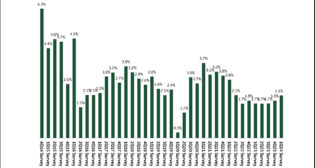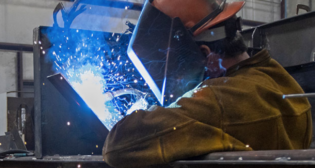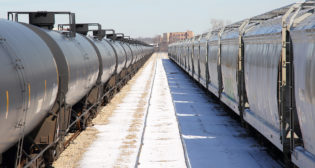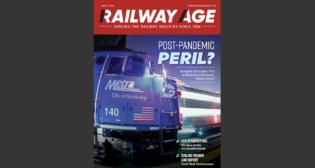
Rudderless rail economy continues trek
Written by David Nahass, Financial Editor
Financial Edge, August 2017 Railway Age: Industry watchers spend a fair bit of time trying to take economic data and translate it into future carloads and railcar deliveries. Recent economic data continues to confound watchers who, several years into an economic downturn (railcar-wise), struggle to reconcile growth in the broad economy with the weakness in railcar and carload data.
There are some high expectations for second-quarter RSI new car orders. After a first-quarter pop of 4,800 orders, many people are expecting an even higher 2Q2017 number. A slight pop in orders is not a trend. The question about the rail market remains unanswered: Is it strengthening, weakening or trending level? Eric Starks, Chairman and CEO of FTR Transportation Intelligence (and perennial Rail Equipment Finance speaker), is an industry maven piecing all this together to pave the path forward. I caught up with Eric and peppered him with a few questions about the direction of the rail economy.
RA: The Institute for Supply Managment’s Purchasing Manager’s Index (PMI) of manufacturing activity is at the highest level since June 2014. The retail economy seems very healthy. What about the rail economy?
Starks: Data suggests that there is manufacturing and factory expansion. However, it is at modest levels; it is inconsistent and very sector-driven. Retail growth has been so-so, but there is no real strength there. Base manufacturing data says the economy looks a little weaker (and the Fed suggests some contraction while the ISM sees expansion) right now. Railcar loading data has been rather flat. Although the year-over-year numbers look good, vs. the baseline the numbers look pretty flat. In rail, other than intermodal, there really has been little expansion. We are seeing an expansion in truck freight.
RA: Earlier in the year, you were suggesting an increase in inventories would drive an increase in manufacturing spending. Has that occurred and do you see a manufacturing slowdown on the horizon?
Starks: There has been a little turn. Companies are willing to add more inventory, but the result is that inventories may not really be right sized; they may be too high. That is a short-term benefit, but it is not good in the long term, especially for transportation. We struggle to find that optimal balance to drive demand for rail transportation.
RA: Inflation also seems to have stalled.
Starks: Yes, there is really no inflationary pressure and no wage pressure and no momentum for either right now. I think the downside is a little overstated, but I am not seeing improvement there.
RA: What about construction spending. That seems to have stalled. Should we be concerned?
Starks: We had seen some growth in multi-family homes. But there was a slowdown in the building of office space and hotels. We still have an inventory hangover from the Great Recession. Spending on oil and gas was masking part of that. So there was infrastructure spending, but it was all mainly focused in one industry. It wasn’t false growth, but it gave the sense that growth was stronger than reality. We are seeing that again. There was strong growth in 1Q2017, but it was all in oil and gas. Construction has room for improvement.
RA: The dollar has been weakening. Does that change the perspective on U.S. exports and railcar loadings?
Starks: It will take some time for momentum to build behind exports. There is significant global competition, and at the outset, global economic weakness limits end market potential. There is some growth in Europe, but overall growth is limited. The currency move isn’t enough to change the equation on price for most commodities. For example, there is a global glut of grain. A currency price improvement of 2% just does not move the needle enough to cause an impact.
RA: Demand for sand for frac drilling seems to have caused some increase in the placement of new car orders. What are you hearing about the railcar order pace for the remainder of 2017 and 2018?
Starks: We see deliveries for 2017 in the low 40s and toward the mid to high 40s for 2018. We feel deliveries in 2017 are probably too high, and that will have a short-term impact. Going forward, we see compartmentalized growth in markets like sand and plastics. Autos are slowing down. There is some intermodal traffic growth that might cause some orders to occur. The replacement cycle, with scrap at the mid $200s per ton, hasn’t occurred. The scrapping of cars is below historical averages. There is also a cloud over trade and what might happen there. That is hampering activity generally. The majority favors global trade over isolation, but that remains a big unknown.
Great information, as always, from Eric Starks.



